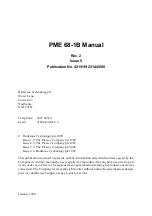
Thermal
and Power Issues
CPC1600
C P C 1 6 0 0 U s e r M a n u a l
56
© 2 0 0 8 F a s t w e l V e r . 0 0 1 E
6.2
System Power
The Intel Pentium M processor family requires special characteristics of the power supply unit and
the baseboard.
The CPC1600 module itself has been designed to provide best possible power supply for each
system unit. However, in order to guarantee reliable and faultless operation the following
requirements must be taken into account. Absolute maximum input voltage presented in the table
below must not be exceeded to guarantee that the CPC1600 is not damaged. The range for the
input power voltage, within which the module is functional, is also presented.
Table 6-1:
DC Input Voltage Ranges and Limits
Power Voltage, V
Maximum Permitted Value, V
Absolute Limits, V
Recommended Range, V
+5
+5.5
4.9 to
5.25
5.0 to
5.25
Power supplies to be used with the CPC1600 should comply with these requirements.
Input power connections to the baseboard itself should provide minimum power loss. Avoid using
long input lines, low carrying capacity cables, and high resistance connections.
To select the appropriate system power supply, it is necessary to consider the CPC1600 own
power consumption (about 35 watts), the consumption of the remaining system components,
possible variations of power consumption during operation (e.g. due to temperature changes) and
some reserve. Taking all this into account, it is recommended to use a 150 watt power supply. If
possible, power supplies with voltage sensing should be used. This may require an appropriate
baseboard.
Table 6-2:
Some CPC1600 Components Power Consumption
System Modules
Power Consumption
Pentium M 1.6 CPU
24.5 W
915GM+ICH6M Chipset
6 + 2.3 W
DDR SDRAM SODIMM PC2700 1 GB
(2.5 V)
5 W
Gigabit Ethernet chips 2pcs
1548x2 mW
CompactFlash card
(3.3 V)
100 to 300 mW
Keyboard
(5 V)
100 mW























